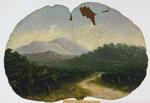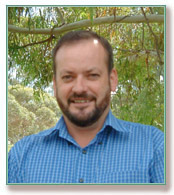Black Dog Creek runs through the Mt. Pilot/Deep Creek/Eldorado run area, (Eldorado Park Station) along either side of the Chiltern-Beechworth Road, flowing west under the Hume Highway towards the Murray River in North East Victoria.
The first Europeans in the area led by Joseph Hawdon who was involved in overlanding cattle to Port Phillip in 1836. Legend says that he shot a rare 'black' dingo and Black Dog Creek was named in its honour.
The first squatters took up land here in 1839 and a bush inn was established in 1844. Some other buildings developed around the hotel - later transformed into a police outpost and often visited by Robert O'Hara Burke, of the famous Burke and Wills expedition.
It was here that Alfred William Eustace settled with his family and friends at a time when several gold rushes were underway in the 1850s. In 1851, Alfred William Eustace, wife Sarah Anne (nee Collins), son Sidney and daughter Kate, arrived at the Eldorado Run and camped near where the Beechworth Road crosses the Black Dog Creek. The next four Eustace children were born in the district: Elizabeth, Charles, Emily and Annie.
Take a trip and retrace the legacy of Black Dog Creek...
The Chiltern Atheneaum is a good point of departure with many of Alfred Eustace's gum leaf paintings on display as well as some works by his youngest daughter, Annie (Jessup). In September 2005 a new music bowl beside the shore of Lake Anderson, was dedicated to Alfred William Eustace, is seen on the left as you head for the Beechworth Road.
The Beechworth Road was busy with gold diggers and the goods and passengers arriving on mail coaches and bullock drays, during the Indigo and New Ballarat gold rushes. In the 1850's the Melbourne to Sydney road included Wangaratta and Beechworth before heading to Wodonga and Albury. Coaches ran daily from Beechworth to Melbourne, Yackandandah and Albury. As you drive today from Chiltern towards Beechworth, shortly after leaving the Hume Highway, in a paddock on the right, you will see a small mullock heap (pile of waste rock) made by the Star Gold Mining Co. and its old Star Gold mine. A short distance further on the left is Brady's Hill, at the foot of the Skeleton Range, where the Ashley, Eustace and Withers families has various mines in the area. These gold-bearing reefs rise to the left, but were not very profitable, so Alfred Eustace made his living as a shepherd and taxidermist, before his fame as a bush artist and poet. Gold was discovered in Beechworth in February 1852, often called the Ovens gold rush and was followed by discoveries at Yackandandah, Nine Mile Creek, Stanley and Wooragee. The three main gold fields areas were Beechworth, Yackandandah and the 'Indigo Goldfield' (Chiltern-Rutherglen). By about November 1852 there were about 8000 miners camped on Beechworth's Spring and Reid's Creek goldfields. Living conditions were hard, with unsanitary conditions and cold and wet winters that increased risk of illness and disease. Amid the success stories, in many ways life on the Beechworth goldfields seems to have been harder and generally less rewarding for the hopeful digger - and his family. Over four million ounces of gold (115 tonnes) were found in the first 14 years after its discovery in 1852. By 1866 the rush was almost over in Beechworth.
Hillgreen is situated on the left hand side along the Black Dog road, just before the right-hand turn off to Deep Creek road and belonged to the family of William and Annie Ashley (nee Withers). Alfred Eustace and members of the Withers families had grown up in Berkshire, England, prior to coming to Australia, so Annie named Hillgreen after the fond memories that she had of her grandfather's home in Berkshire. From Hillgreen, the view of Mt.Pilot stretches across the the Eldorado Park Station, where a brick home was built in 1844 by Captain W. F. Baker RN, with iron lace windows for security. This property of 320 acres was bought from the Captain by Jason Withers in 1851 and was freeholded in 1855. In 30 January 1860, Jason sold 10 acres to his brother William by pre-emptive right, a condition where squatters held the right to buy land at 1 pound per acre from the Crown. In 1869, Alfred Eustace also bought 10 acres of the run from Jason.
On the Deep Creek road is the Mulberry Cottage site to the right on the other side of Deep Creek near some Willow trees. Gold diggers need food and clothing and the gold diggings at Woolshed Falls was a ready market for fresh produce. Her William Withers was a market gardener who supplied the Woolshed diggings with fresh vegetables. Further along on the left was the Upper Black Dog Creek state school, which served the families in the district, in roll call order: Ashley, Byron, Eustace, Garlick, Martin, Olholms, Reece, Towers and Travis families. Alfred Withers and his wife Emily (nee Eustace) lived next to the school and raised a large family.
The deep creek road continues and later a turn to the right into Martin's Lane crosses Deep Creek, which had deep pools in those days, where locals caught some black fish. In the days before a church was built, the area near the creek had an open air baptistry where early converts were immersed in the waters of the creek, includng Alfred's daughter, Elizabeth.
Continue the journey along the Beechworth Road and enter the unique white box Eucalypt forest area as you get closer to the Mt. Pilot turn-off to the left. If you get a chance to stop safely, take a closer look at the white box trees, with the large juvenile leaves that Alfred Eustace used in his gum leaf paintings. Soon you enter the area of Gidley's Gap, where the Gap Inn had a shady past, but is now among the forest with some recent buildings and a dam. The Gap Inn was burnt down 3 times with some lives lost. Gidley was a suspected cattle rustler and was known to the Ned Kelly gang. Both Thomas Gidley and Ned Kelly spent some time in Beechworth Gaol which was built 1857 to 1860.
Take the left turn along the Old Coach Rd to the Mt. Pilot reserve and climb to the top of this granite hill to see the panoramic view. The summit of Mt Pilot is 548 m above sea-level. The mountain was important to local Aboriginal clans as a spiritual and ceremonial site. Springs in the rocks here were also an essential water source.The view towards Chiltern includes the land that Jason Withers held from the Crown as well as the Ullina run futher away and Mt Saddleback, Mt Barambogie and the Skeleton range. It is thought that Captain Baker gave Mt Pilot and 'Little Pilot' their names (pilot of the watch).
The famous Woolshed Falls diggings were a busy place. After Mt.Pilot, the next turn off the Beechworth Road to right is to the falls. Aaron Sherritt was shot here by the Kelly gang. Sherrit was a life-long friend of Joe Byne, another Woolshed lad and Kelly gang member, but had 'fingered' Joe to the police, so Joe shot him. The Kelly Gang knew that when news of Aaron Sherritt's murder in 1880 was telegraphed to Melbourne a party of police would be sent to Beechworth, the nearest point to the Sherritt home. This event triggered the Glenrowan Inn seige on 27 June 1880 and the eventual demise of the Kelly Gang. Local Superintendent, John Sadlier, who desribed Eustace's painting in his notes, received 240 pounds 17/3 as his share of the 8000 pound reward offered on the Kelly gang.
On another occasion, the miners led their political candidate, Daniel Cameron, into Beechworth a on a horse shod with shoes made of gold. Cameron mounted the horse with the Golden Horshoes and entered Beechworth with a procession of runners giving out free beer. The landscape around Woolshed Falls was a favourite area to be painted by Alfred Eustace, including those painted on the white box gum leaves.
The road lead to Eldorado where the Cocks Poineer Dredging Co. recovered many ounces of gold and the dredge ruins still exist sunken in water. Near Reid's creek Edmund Poynter and William Ashley made and lost a fortune! William Withers sent William and Annie to the Woolshed school. It may be here that she met William Ashley (her future husband) who she married at 15 years of age.
In Beechworth, a visit to the Burke museum (Robert O'Hara Burke) complements the collection of Eustace works found at the Chiltern Atheneaum and the Jindera NSW and Yackandandah museums. At the back of the Burke museum is a collection of animals which Alfred Eustace prepared as a taxidermist for the museum. One of the paintings here by Eustace is titled 'The Woolshed Diggings', show a scene of the Woolshed Gold Rush, with Alfred Eustace appearing, Hitchcock-like, in his Sunday best clothes in the background, observing the action. This painting, plus one photograph, are the only known record of the diggings.
 Artworks Gallery
Artworks Gallery
Poetry
by
A W Eustace
Black Dog Creek
This site archives the family history of the friends and
relatives of A W Eustace.
See the Black
Dog Creek Blog which documents progress and contributors
of information to this archive.
Black Dog Tails
Alfred Eustace [1820-1907] Pioneer bush artist, shepherd (Eldorado Run) , poet & taxidermist of Black Dog Creek and Chiltern, VIC. Alfred painted landscape scenes on White-box eucaypt leaves (see photo). Exhibitions in Albury (1864) and in Melbourne (1884). A long time friend of Jason, Thomas and William Withers, Alfred and his family came to the Black Dog creek district to shepherd sheep. It was here that he learnt to paint.
Elizabeth Eustace [1852-1959] Daughter of A W Eustace, Elizabeth was the first female born in Albury NSW and oldest living Australian before her death at 106.
A tale of two Betty's. In 1954 at the age of 102, Elizabeth Eustace was taken to Benalla Railway Station where she was greeted in person by Queen Elizabeth II on her first Royal Tour of Australia.
Eustace Families Post. Ron Eustice of Minneapolis USA and Jim Eustice in South Australia edit and distribute the Ron Eustice Minneapolis USA and Jim Eustice SA Australia edit and distribute the "Eustace Families Post" as a global source.
Brian Allison is my cousin, an artist and is also a great-great grandson of A W Eustace and sent some photos for use in the gallery.
Joan & Jeff Crisdale provided some interesting family history on a Garlick-Eustace connection from history of Mary Rose's family as a PDF file.
 Ken's
Profile is here
and there is the Squirrelmail
link.
Ken's
Profile is here
and there is the Squirrelmail
link.
Border Studies MOODLE site
for people who who want to learn together on the basis of
their and others research.